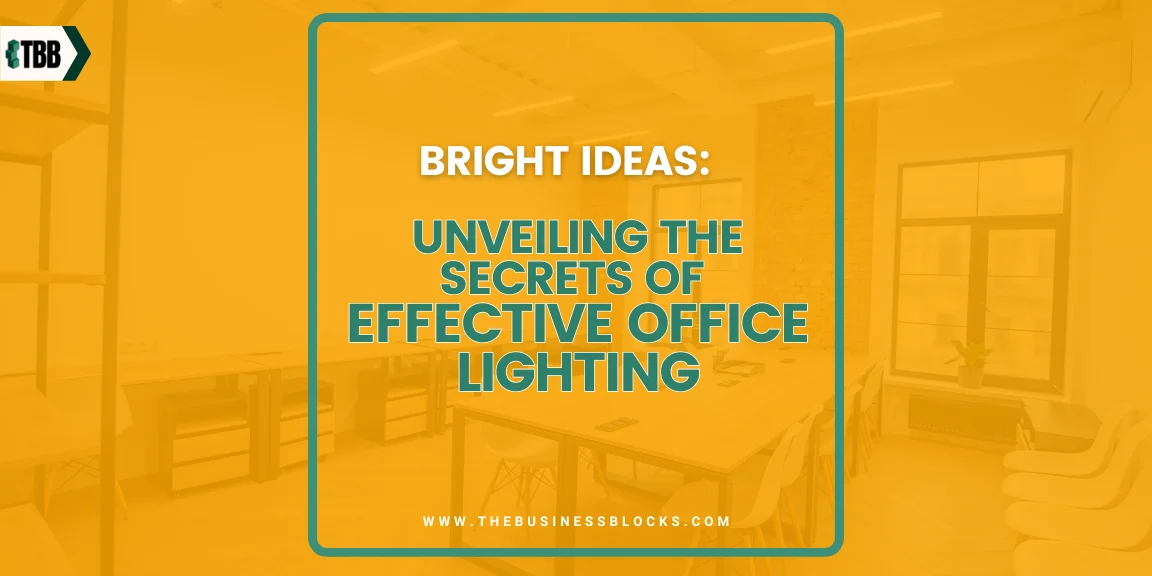In the world of office environments, lighting isn’t just about banishing shadows; it’s an art and a science that significantly impacts productivity, mood, and overall well-being.
Join us as we shed light on the science behind creating the perfect balance, ensuring that your workspace is not only well-lit but also tailored to enhance focus, creativity, and employee satisfaction. Get ready to unveil the secrets that turn a mundane office into a vibrant, energizing, and inspiring haven where work becomes a joy.
Ready to revolutionize your office lighting?
Imagine a workplace where every corner is bathed in the perfect glow – a setting that not only meets but exceeds the lighting needs of your team. With insights into optimal design principles and cutting-edge solutions, you’ll be empowered to create an office space that everyone desires to work in.
From harnessing natural light to embracing innovative technologies, this guide is your passport to a brighter, more invigorating workspace. Elevate your workspace, boost morale, and make your office the beacon of success it’s destined to be.
Don’t let your office remain in the shadows. Keep reading and let us be your guiding light!
What is an Effective Office Lighting?
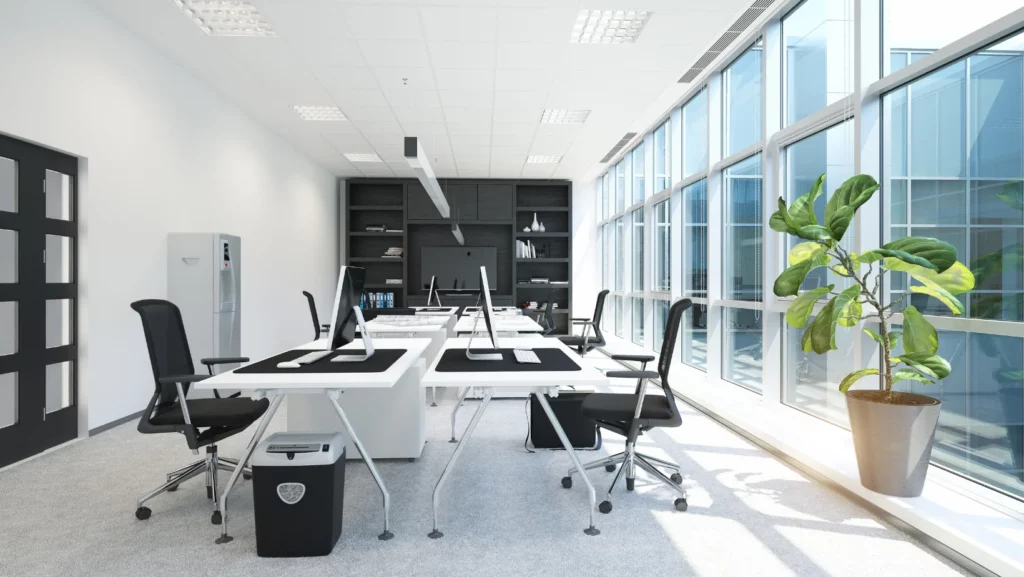
Effective office lighting refers to a carefully planned and well-executed illumination strategy designed to enhance the work environment within an office space. It goes beyond the simple provision of light and takes into consideration factors such as the quality, quantity, and distribution of light to create an optimal working atmosphere.
Did you know?
- The Future Workplace Employee Experience Study found that 78% of employees say access to natural light and views improved their well-being and 70% report improved work performance.
- When working in spaces with good natural lighting (i.e., from sunlight), blurred vision, headaches, and eye strain are reduced by up to 84 percent, according to the results of research by Cornell University’s Department of Environmental Design and Analysis.
Effective lighting in the workplace is crucial for several reasons, impacting both the physical environment and the well-being of employees.
Here are some key aspects highlighting the importance of effective lighting:
Enhanced Productivity:
Well-designed lighting can improve focus and concentration, leading to increased productivity among employees. Proper illumination of work areas supports task performance and reduces errors.
Reduced Eye Strain and Fatigue:
Insufficient or improperly distributed lighting can result in eye strain and fatigue. Effective lighting helps create a comfortable visual environment, reducing the likelihood of discomfort and headaches.
Mood and Well-Being:
Quality lighting contributes to a positive atmosphere, influencing the mood and well-being of employees. Natural light, in particular, has been linked to enhanced mood and reduced stress levels.
Optimized Circadian Rhythms:
Exposure to natural light and appropriate lighting temperatures during the day helps regulate circadian rhythms. This can improve sleep quality, alertness, and overall health.
Increased Safety:
Adequate lighting is crucial for maintaining a safe working environment. It helps prevent accidents, reduces tripping hazards, and ensures clear visibility of emergency exits and evacuation routes.
Enhanced Visual Comfort:
Effective lighting design considers factors like minimizing glare, controlling brightness levels, and providing uniform illumination. This enhances visual comfort and reduces visual discomfort associated with harsh lighting conditions.
Support for Diverse Tasks:
Different tasks require varying levels and types of lighting. Effective lighting design accommodates the diversity of tasks within a workplace, offering flexibility and customization options.
Energy Efficiency:
Smart lighting systems that adjust based on natural light availability and occupancy contribute to energy efficiency. This not only reduces operational costs but also aligns with sustainability goals.
Positive Work Environment:
A well-lit workspace creates a positive and inviting ambiance. Employees are more likely to feel motivated and engaged in a well-designed, well-lit office environment.
Compliance with Regulations:
Many regions have workplace lighting regulations to ensure the health and safety of employees. Effective lighting ensures compliance with these standards, avoiding legal issues and penalties.
Effective lighting is not just about providing illumination; it’s a fundamental aspect of creating a conducive and healthy work environment. From boosting productivity to fostering employee well-being, the impact of lighting extends across various facets of the workplace experience.
Different Types of Lighting for Offices
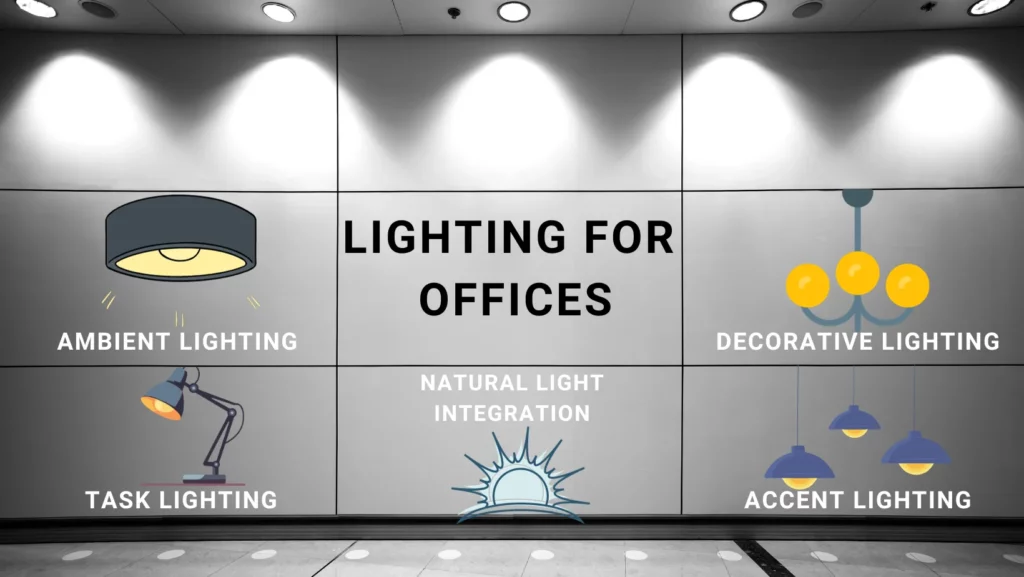
Let us give you some ideas of some types of lightning that will be good for different offices depending on different needs and preferences.
Ambient Lighting: This provides overall illumination, creating a comfortable and well-lit environment across the entire office. Typically achieved through ceiling-mounted fixtures or indirect lighting sources, ambient lighting ensures a consistent level of brightness without harsh shadows.
Task Lighting: Task lighting is designed to meet specific work requirements, reducing eye strain and enhancing focus. Desk lamps, under-cabinet lights, and adjustable fixtures are common sources of task lighting, illuminating individual workstations or designated areas for detailed tasks.
Accent Lighting: Used to highlight specific features or areas within the office, accent lighting adds visual interest and depth. It may include track lighting, wall-mounted fixtures, or directional spotlights that draw attention to architectural elements, artwork, or other focal points.
Natural Light Integration: Maximizing the use of natural daylight through architectural design, large windows, and open layouts. This type of lighting not only enhances the visual appeal but also contributes to employee well-being and energy efficiency.
Decorative Lighting: While not necessarily functional for task-oriented activities, decorative lighting, such as pendant lights or chandeliers, adds aesthetic appeal and contributes to the overall design theme of the office, creating a visually pleasing atmosphere.
The Secrets of Effective Office Lighting
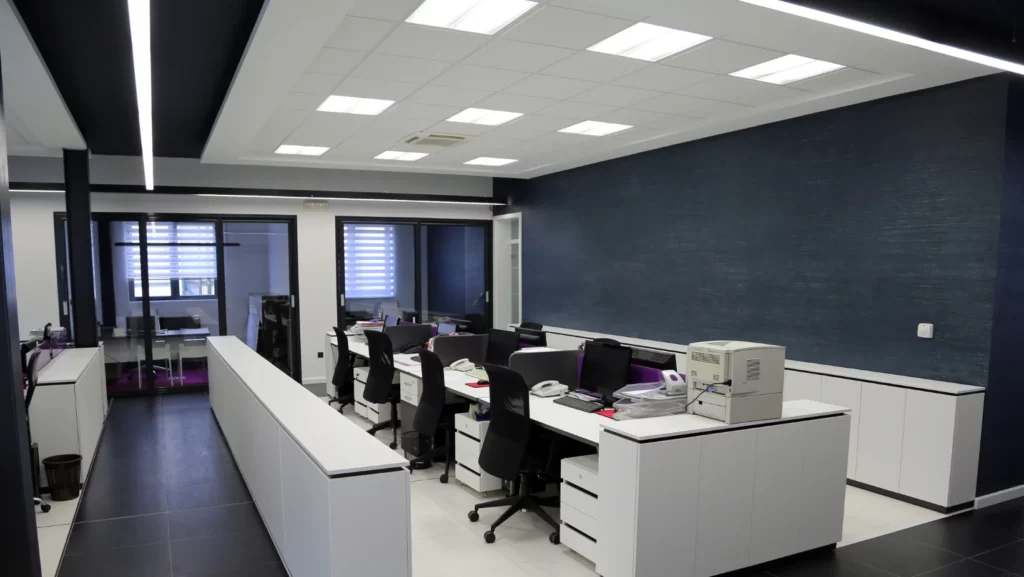
The secrets of effective office lighting design lie in the thoughtful consideration of various factors to create an environment that enhances productivity supports well-being and contributes to the overall success of the workplace.
Here are some key aspects that reveal the secrets of effective office lighting design:
Task-Specific Illumination
- Task-specific illumination is a critical aspect of office lighting design that involves customizing lighting solutions to match the specific tasks performed in different areas of the workplace. The goal is to provide optimal lighting conditions that enhance productivity, reduce eye strain, and support focused work.
- By customizing lighting solutions to specific tasks and work zones, employers can create a more comfortable and conducive environment for employees, ultimately contributing to a more productive and satisfying work experience.
Natural Light Integration
- Natural light integration in office design involves maximizing the use of natural daylight to illuminate the workspace. This design approach recognizes the numerous benefits associated with natural light, including its positive impact on mood, well-being, and overall productivity. Architects and designers strategically position workspaces to take advantage of available daylight, often incorporating large windows, skylights, and open layouts to allow the ingress of natural light throughout the office.
- Effective natural light integration considers the orientation of the building, window placement, and the use of light-reflective materials to distribute sunlight evenly. Additionally, it involves minimizing obstructions that could block or diffuse natural light, ensuring that workstations receive ample illumination. As a result, workplaces that prioritize natural light integration create a healthier and more comfortable environment for employees, fostering both physical and mental well-being.
Color Temperature Consideration
- Color temperature consideration in office lighting refers to the warmth or coolness of the light emitted by artificial sources and is measured in Kelvins (K). Warm color temperatures, typically ranging from 2700K to 3000K, produce a soft, yellowish light akin to incandescent bulbs, creating a cozy and inviting atmosphere. In contrast, cool color temperatures, around 5000K to 6500K, emit a bluish-white light resembling natural daylight, providing a more energizing and alert ambiance.
- Choosing the appropriate color temperature is crucial for creating the desired mood and functionality in different areas of the office. Warm tones are often preferred in relaxed or collaborative spaces to promote a comfortable and welcoming environment, while cool tones are suitable for task-oriented areas where increased focus and concentration are required. Striking the right balance in color temperature considerations contributes to a well-designed lighting scheme that enhances both the aesthetics and functionality of the workspace, supporting the diverse activities conducted in various office zones.
Balanced Ambient Lighting
- Balanced ambient lighting in office design involves achieving uniform illumination throughout the workspace to provide a comfortable and visually consistent environment. This approach ensures that every corner of the office receives an adequate level of light, minimizing shadows and creating a well-lit atmosphere conducive to productivity. Architects and lighting designers strategically position fixtures, such as ceiling-mounted lights or indirect lighting sources, to distribute light evenly, avoiding overly bright or dim areas.
- The goal of balanced ambient lighting is to eliminate glare, reduce eyestrain, and maintain a consistent lighting level that supports a variety of tasks. By creating a harmonious distribution of light, employees experience a visually comfortable setting that enhances their ability to focus, collaborate, and engage in various work activities. This design principle contributes to a healthier and more aesthetically pleasing workplace, promoting a positive atmosphere that supports employee well-being and overall job satisfaction.
Layered Lighting Design
- Layered lighting design is a strategic approach that involves the integration of multiple lighting sources to create a versatile and adaptable environment. Combining ambient, task, and accent lighting allows for the customization of lighting scenes tailored to specific activities and moods within the office. Ambient lighting provides overall illumination, ensuring a well-lit background, while task lighting caters to specific work requirements, reducing eye strain and improving focus. Accent lighting adds depth and visual interest, highlighting architectural features or creating specific focal points.
- This layered approach not only enhances functionality but also contributes to a dynamic and aesthetically pleasing workspace. The flexibility to adjust lighting levels according to different needs empowers employees to create an atmosphere that suits diverse work tasks and fosters a comfortable and engaging environment. Embracing a layered lighting design supports both the practical aspects of work and the overall visual appeal of the office.
Energy-efficient lighting solutions
- Energy-efficient lighting solutions in office design involve incorporating technologies and practices that minimize energy consumption while maintaining optimal illumination. This can be achieved by using LED fixtures, which are known for their high energy efficiency and long lifespan. Additionally, implementing smart lighting controls, such as occupancy sensors and daylight harvesting systems, helps regulate light levels based on occupancy and available natural light, reducing energy usage.
- By adopting energy-efficient solutions, offices not only contribute to environmental sustainability but also benefit from reduced energy costs. LED lighting, in particular, consumes less power, produces minimal heat, and has a longer operational life, resulting in lower maintenance and replacement expenses. Energy-efficient lighting solutions align with the growing emphasis on sustainability in workplace design, offering a practical and cost-effective approach to lighting that benefits both the environment and the bottom line.
Designing effective office lighting involves implementing a combination of strategies and considerations to create a well-lit and functional workspace. These strategies collectively contribute to an effective office lighting design that prioritizes both functionality and aesthetics.
How does office lighting affect productivity?
Office lighting plays a crucial role in influencing productivity in the workplace. Here’s how:
Visibility and Task Performance
Proper lighting ensures that employees can see their tasks and documents clearly, reducing eyestrain and errors. Well-lit workspaces contribute to efficient task performance by providing the necessary visibility.
Mood and Alertness
Adequate lighting, especially with the inclusion of natural light, affects employees’ mood and alertness. Exposure to natural light stimulates the production of serotonin, a neurotransmitter linked to positive mood and increased attentiveness, contributing to a more focused and productive workforce.
Reducing Fatigue
Inadequate or poorly distributed lighting can lead to eye fatigue and overall tiredness. Properly designed lighting helps combat fatigue, keeping employees more energized throughout the day, and leading to sustained productivity.
Circadian Rhythms:
Exposure to natural light or dynamic lighting that mimics natural daylight helps regulate circadian rhythms. This can improve sleep quality and overall well-being, positively impacting daytime alertness and productivity.
Workspace Organization
Well-lit spaces with defined lighting zones help employees understand and navigate the workspace better. This clarity reduces confusion, making it easier for individuals to locate resources and move seamlessly between different areas, enhancing overall efficiency.
The right office lighting contributes to a comfortable, energizing, and well-organized work environment, fostering a positive atmosphere that supports employee productivity and well-being.
How to Choose the Right Office Lighting
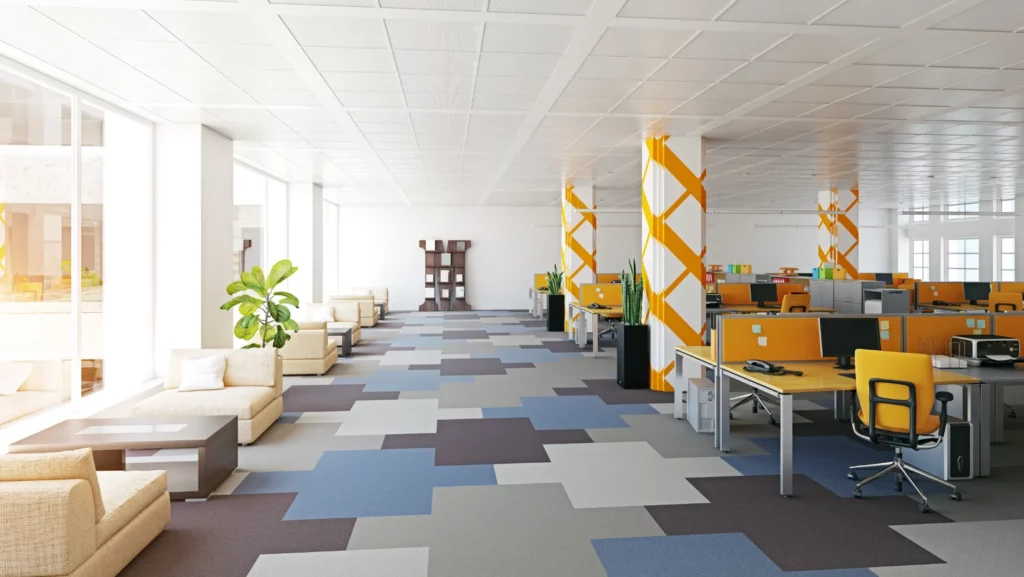
Choosing the right office lighting involves considering various factors to create a productive and comfortable work environment.
Here’s a guide to help you make the right choices:
1. Understand the Space
Assess the different areas within your office, considering the nature of work in each zone. Task-oriented areas may require brighter lighting, while collaborative spaces might benefit from softer, ambient lighting.
Understanding the space in your office is crucial for effective lighting design. Each area serves a unique purpose, and tailoring the lighting to match the nature of the work enhances both functionality and comfort.
For example, the following areas require different lighting:
- Task-Oriented Areas: In work zones where tasks that demand precision and focus are performed, such as individual workstations, task-oriented lighting is key. Bright, direct lighting helps employees carry out detailed work effectively, reducing eye strain and improving concentration. This can be achieved through desk lamps, overhead lights, or focused spotlights.
- Collaborative Spaces: atmosphere, fostering communication and teamwork. Pendant lights, indirect fixtures, or wall sconces can contribute to a comfortable environment without causing visual discomfort during interactions.
- Reception and Waiting Areas: First impressions matter in reception and waiting areas. Here, a combination of ambient and decorative lighting is often used to create a welcoming and aesthetically pleasing environment. Chandeliers, pendant lights, or stylish fixtures can add a touch of elegance while maintaining adequate brightness.
By carefully assessing the unique requirements of each area, you can implement a well-rounded lighting strategy that enhances both productivity and the overall ambiance of your office space.
2. Determine what type of Office Lighting you need
Determining the type of office lighting you need involves understanding the different lighting requirements for various areas within the workspace.
Here’s a guide to help you identify the right lighting for different areas within your workspace:
- Task Lighting:
- Where to Use: Individual workstations, desks, and areas where detailed tasks are performed.
- Why: Provides focused and adjustable illumination for specific tasks, reducing eye strain and improving concentration.
- Examples: Desk lamps, under-cabinet lights, and adjustable spotlights.
- Ambient Lighting:
- Where to Use: Throughout the office for overall brightness and a well-lit environment.
- Why: Ensures a comfortable level of illumination without harsh shadows, creating a pleasant atmosphere.
- Examples: Ceiling-mounted fixtures, recessed lights, and indirect lighting.
- Collaborative Spaces:
- Where to Use: Meeting rooms, open-plan workspaces, and areas where teamwork and communication occur.
- Why: Balances ambient and task lighting for a comfortable and conducive environment for collaboration.
- Examples: Pendant lights, track lighting, adjustable fixtures.
- Reception and Waiting Areas:
- Where to Use: Entryways, waiting rooms, and areas where visitors are received.
- Why: Creates a welcoming and aesthetically pleasing atmosphere, making a positive first impression.
- Examples: Chandeliers, decorative fixtures, and wall sconces.
- Breakout or Lounge Areas:
- Where to Use: Informal spaces for relaxation, socializing, or casual meetings.
- Why: Utilizes softer lighting to promote a comfortable and inviting ambiance.
- Examples: Floor lamps, pendant lights with warm tones, and decorative lighting.
By considering the specific functions of each area, you can tailor your office lighting to enhance both productivity and the overall well-being of your employees.
3. Consider Energy Efficiency
Considering energy efficiency in office lighting is crucial for creating a sustainable and cost-effective workspace.
Here’s why it matters and some strategies to achieve energy-efficient lighting:
- Environmental Impact: Energy-efficient lighting reduces the carbon footprint of your office, contributing to environmental sustainability. Choose LED or CFL bulbs, which are more energy-efficient than traditional incandescent bulbs. Implementing smart lighting systems with occupancy sensors and timers can also minimize unnecessary energy consumption.
- Cost Savings: Energy-efficient lighting solutions lead to significant cost savings on electricity bills over time. Invest in energy-efficient LED fixtures and bulbs that have longer lifespans and lower energy consumption. Implement lighting controls like occupancy sensors to automatically turn off lights in unoccupied areas, further reducing energy costs.
- Improved Longevity: Energy-efficient lighting technologies, such as LED bulbs, generally have longer lifespans, reducing the frequency of replacements. Opt for LED lighting, which not only consumes less energy but also lasts longer than traditional bulbs. This reduces the need for frequent replacements, minimizing waste and maintenance costs.
- Regulatory Compliance: Many regions have energy efficiency regulations that businesses must comply with. Adhering to these regulations is essential for legal and environmental responsibility. Stay informed about energy efficiency standards and regulations in your area. Ensure that your office lighting installations comply with these standards to avoid penalties and contribute to a greener environment.
- Employee Well-being: Properly designed energy-efficient lighting contributes to a healthier and more comfortable work environment, positively impacting employee well-being and productivity. Optimize natural light utilization, implement ergonomic lighting design, and use energy-efficient bulbs with appropriate color temperatures to enhance employee comfort and performance.
By integrating energy-efficient lighting practices into your office, you not only reduce operational costs but also contribute to a sustainable and environmentally responsible workplace.
4. Choose the Right Design
Customizing or choosing the right design of lighting in your office is essential for creating a visually appealing, functional, and productive workspace.
Here’s why customization matters and some strategies for achieving the right lighting design:
- Tailored to Work Zones: Different areas within the office have distinct purposes, and customizing lighting allows you to cater to specific needs in each work zone. Identify task-oriented areas that require focused lighting and collaborative spaces that benefit from ambient lighting. Use a mix of direct and indirect lighting to create a well-balanced environment.
- Brand Identity and Aesthetics: Customized lighting designs can reflect your brand identity and contribute to the overall aesthetics of your office. Choose lighting fixtures and designs that align with your brand’s colors, style, and overall theme. Incorporate creative lighting elements that enhance the visual appeal of the space.
- Employee Preferences: Employee comfort and satisfaction are crucial for a positive work environment. Customized lighting takes into account individual preferences and needs. Consider adjustable lighting options or individual desk lamps to allow employees to personalize their lighting. Survey employees to understand their preferences regarding brightness and color temperature.
- Flexibility for Various Activities: Customized lighting designs provide flexibility to adapt to different activities within the office, from focused work to meetings and recreational areas. Implement a layered lighting approach, combining ambient, task, and accent lighting. Use dimmable fixtures or smart controls to adjust light levels based on the time of day or specific tasks.
Choosing the lighting design in your office goes beyond mere functionality—it becomes a key element of your office culture, branding, and employee satisfaction. By tailoring lighting to specific needs and preferences, you create a workspace that promotes well-being, productivity, and a positive atmosphere.
10 Common Lighting Problems in the Workplace
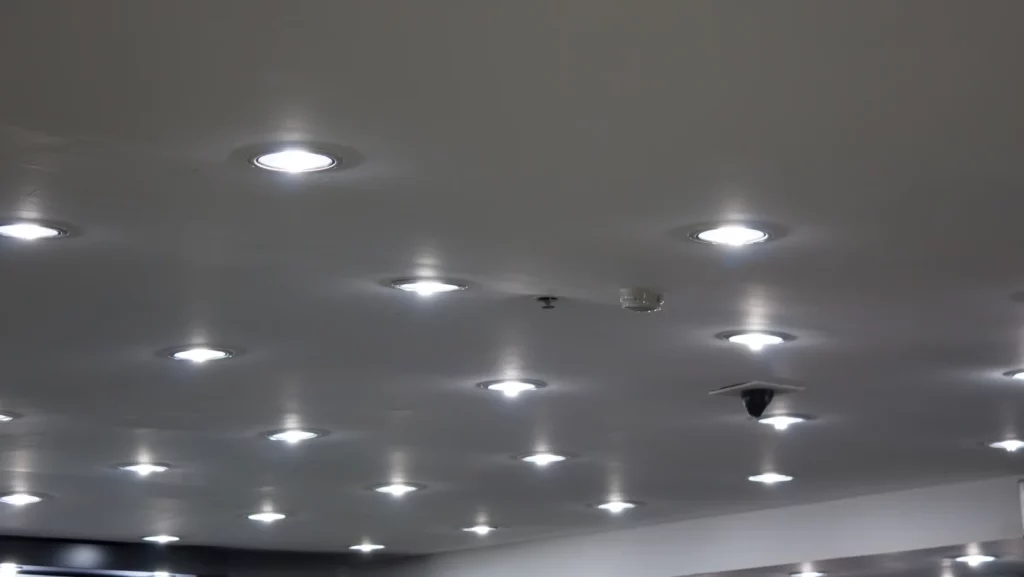
Several common lighting problems can impact the workplace, affecting employee well-being, productivity, and overall comfort. Here are some of the most prevalent issues:
1. Insufficient Lighting:
- Problem: Dim or inadequate lighting can strain the eyes, leading to discomfort and decreased productivity.
- Solution: Ensure proper illumination by adding more light fixtures, increasing natural light access, or using brighter bulbs. Consider task lighting for specific work areas.
2. Glare:
- Problem: Excessive glare from natural or artificial light sources can cause eye strain and discomfort.
- Solution: Use anti-glare coatings on screens, position lights strategically to minimize glare, and utilize window coverings or blinds to control natural light.
3. Flickering Lights:
- Problem: Flickering lights can be distracting and may contribute to headaches and eye fatigue.
- Solution: Replace or repair malfunctioning bulbs or fixtures promptly. Consider switching to LED lighting, which typically doesn’t flicker.
4. Inconsistent Lighting Levels:
- Problem: Uneven lighting levels across the workspace can create shadows and make certain areas less usable.
- Solution: Implement a well-balanced lighting design with a mix of ambient, task, and accent lighting. Ensure uniform illumination throughout the space.
5. Color Temperature Mismatch:
- Problem: Inconsistent color temperatures between different light sources can affect the overall visual appeal and mood in the office.
- Solution: Choose light sources with consistent color temperatures. Consider using adjustable or tunable lighting systems to match the desired ambiance.
6. Lack of Natural Light:
- Problem: A deficiency in natural light can lead to a gloomy and less energizing workspace.
- Solution: Maximize access to natural light by optimizing window placement and removing obstructions. Consider open office layouts to allow light penetration.
7. Overhead Lighting Glare:
- Problem: Direct overhead lighting can cause discomfort, especially if it creates harsh shadows or reflects off shiny surfaces.
- Solution: Use diffusers or indirect lighting to minimize glare. Opt for fixtures with adjustable angles to direct light where needed without causing glare.
8. Inadequate Task Lighting:
- Problem: Some workstations may lack proper task lighting, making it challenging for employees to focus on specific activities.
- Solution: Introduce task lighting, such as desk lamps or under-cabinet lights, to provide additional illumination for detailed work.
9. Outdated Lighting Fixtures:
- Problem: Aging or outdated fixtures may not only affect aesthetics but also contribute to inefficient lighting.
- Solution: Upgrade to modern, energy-efficient fixtures that align with current lighting standards. Consider implementing smart lighting solutions for enhanced control.
10. Limited Lighting Control:
- Problem: Insufficient control over lighting levels can hinder employees from personalizing their workspace.
- Solution: Implement dimmers, occupancy sensors, or smart lighting systems to give employees more control. Encourage individualized lighting setups where possible.
Addressing these common lighting issues requires a thoughtful approach to lighting design, regular maintenance, and consideration of employee needs. By creating a well-lit and comfortable environment, workplaces can positively impact employee well-being and productivity.
Frequently Asked Questions About Bright Ideas: Unveiling the Secrets of Effective Office Lighting
Q: Why is office lighting design important?
A: Effective office lighting design impacts employee well-being, productivity, and overall comfort. It contributes to a conducive work environment and influences mood and focus.
Q: What is task-specific illumination?
A: Task-specific illumination involves identifying different work zones in the office and tailoring lighting solutions to meet the specific tasks performed in each area. This helps reduce eye strain and supports focused work.
Q: How does natural light integration benefit offices?
A: Integrating natural light into office spaces improves mood, enhances well-being, and reduces energy consumption. It creates a more dynamic and visually appealing environment.
Q: Why is color temperature consideration crucial in office lighting?
A: Color temperature affects the ambiance of the workspace. Warm temperatures create a cozy atmosphere, while cool temperatures promote alertness. Choosing consistent color temperatures is essential for a cohesive lighting design.
Q: What is balanced ambient lighting?
A: Balanced ambient lighting involves achieving uniform light levels throughout the office. It combines ambient, task, and accent lighting to create different lighting scenes for various activities and moods.
Final Thoughts
By revealing the secrets behind task-specific illumination, natural light integration, and balanced ambient lighting, this guide empowers you to create an environment that fosters productivity and well-being. Considering color temperature, exploring layered lighting designs, and adopting energy-efficient solutions further contribute to a workspace that goes beyond functionality – it becomes a dynamic, inspiring hub for creativity and collaboration. As you embrace these bright ideas, let them shine a light on a future where your office not only meets but exceeds its illuminating potential. Here’s to a brighter, more vibrant, and productive workspace ahead!

